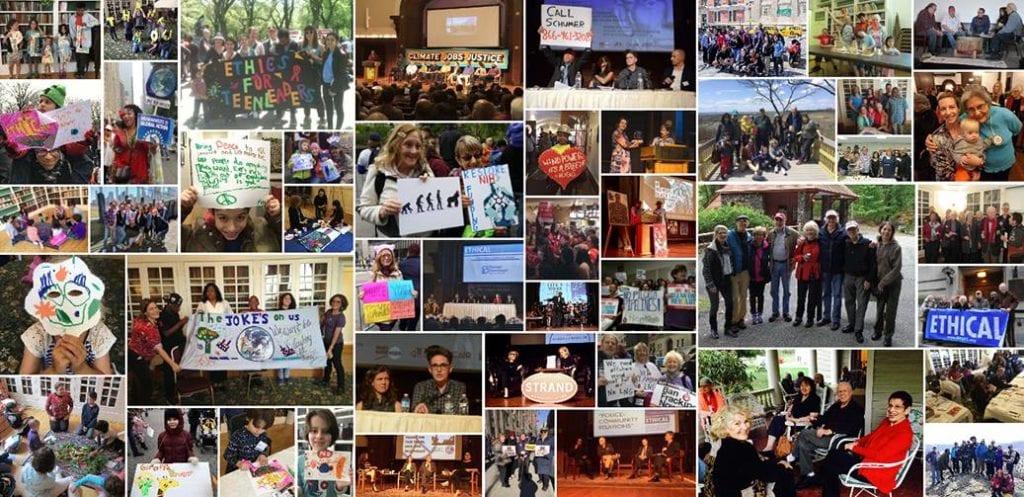
I don’t remember when it started, but when our children were young, they wanted us to toast at dinner and clink our four glasses together. I called out “L’chaim – to life!” and it became a family tradition. One evening at the end of August, this ritual took on a special meaning as I told my children, now adults, about a young woman, a freshman at Columbia University where I serve as Ethical Humanist chaplain, who fell to her death from a 14th floor dorm room and landed on the corner of 114th Street and Amsterdam Avenue where she was discovered by two classmates. It happened only hours after new student orientation; classes hadn’t started yet.
Martha Corey-Ochoa was valedictorian of her high school class in Dobb’s Ferry, Westchester County. “It feels really good,” she told the Rivertowns Daily Voice about this distinction. “I feel like it’s something I’ve been working toward for many years, and I’m glad it’s finally come to pass.” She planned to double major in English and math at Columbia and looked forward to earning a Ph.D. and teaching mathematics at a university, while continuing to write poetry and compose music for the violin, an instrument she played since the third grade. She was also working on a novel. Dobbs Ferry school superintendent Lisa Brady called Corey-Ochoa a brilliant student who maintained a challenging course load. Her father, who called his daughter “gentle and intense,” said that she “was my life and, without her, my life seems to be gone.”
Why did she do it? That’s what everyone wanted to know. Why would a young person with what most people would consider a bright future kill herself?
My mother, who was probably depressed all of her life, often talked of suicide. As a child, I remember her talking about driving the family car off the road into a ditch. When she was in a nursing home during the last months of her life, suicide was a common refrain, although she no longer had the means to accomplish it. As a child, I was frightened; as an adult, I understood, and I think she was surprised when I told her that. Catholic theology taught Mom that committing suicide was a mortal sin that would damn her to hell, and I am convinced that her faith (and fear) is what kept her alive.
Young Martha was a Catholic, too.
I have officiated at two memorials for suicides: both middle-aged married men with children. One hanged himself in the basement of his home; the other breathed carbon monoxide in the cabin of his boat. Their families made no secret of the causes of their deaths, and their memorials addressed the pain they had endured for so long. Few are the families untouched by suicide. After each memorial, I heard stories about loved ones who had taken their own lives, and received thanks for not hiding the truth, a common experience for what is still considered a shameful act, even a sin.
I can only imagine the well of pain from which the urge to kill oneself comes. That pain has many causes. Teenagers are bullied and don’t believe the slogan “It gets better.” Students set lofty goals, or are given them by demanding parents, and feel they can never reach them. Veterans return home and are tormented by memories of war. Depression envelops some people and casts them into an impenetrable prison from which death is the only escape. For every suicide there is a different stimulus, but at its core is a sense of worthlessness.
Ethical Culture founder Felix Adler drew a distinction between worth and value. The former is inherent and inviolable in every individual; the latter is defined in terms of one’s usefulness. It is an ethical act to choose to attribute worth and dignity to everyone no matter what his or her value may be. Adler bemoaned those who did not act ethically towards themselves, who thought themselves worthless.
To live or not to live is an ethical choice. Some suicides can be prevented; some pain can be eased. This is especially true for the young who cannot see a future beyond the moment in which they are suffering. At the end of my essay is information about indicators of possible risks and resources for prevention. You can save someone’s life. Listen to others, observe their behavior, reflect back caringly what you hear and see, offer them empathy, and seek counseling.
Last night my family gathered for dinner. We lifted our glasses, and I called out “L’chaim – to life!” as we clinked them together. I recalled a verse from “Fiddler on the Roof”:
To life, to life, l’chaim.
L’chaim, l’chaim, to life.
Life has a way of confusing us,
Blessing and bruising us.
Drink, l’chaim, to life!
* * * * *
Excerpted from a Columbia University bulletinThere is no simple formula for determining if someone is severely depressed and/or at risk for suicide, but there are behavioral “red flags” that may warrant seeking professional assistance. The more signs that are present, the greater the cause for concern.
* Suicidal thoughts, even if indirect. “I don’t ever want to wake up again.” “Everyone would be better off if I just died.”
* Talking about “not being around” or about death. “What’s the difference? I won’t be here anymore for finals.” Giving away personal possessions.
* Extremely depressed mood, feelings of hopelessness, despair. “I feel like I’m in a hole and I can never get out. Things will never change.”
* Expressions of helplessness, loss of personal agency
* Dramatic changes in personality, presentation, hygiene, or functioning
* High levels of anger, aggression or, alternatively, flattening of emotional expression, profound indifference
* Reckless, risky or impulsive behavior
* Thinking not grounded in reality; delusional beliefs
* Very diminished self-esteem; chronic feelings of guilt, worthlessness
ResourcesNational Suicide Prevention Lifeline: 1-800-273-TALK (8255)
The Trevor Project for LGBTQ youth: 1-866-488-7386
Speak Suicide Prevention Education at http://www.omh.ny.gov/omhweb/speak/: SPEAK is an information kit for the public, health care providers and educators to help them understand the terrible frequency and toll of suicide, and to discover ways and methods to aid in preventing it.
Suicide Prevention Initiatives at http://www.suicidepreventioninitiatives.org/
The Jed Foundation at http://www.jedfoundation.org/: The Jed Foundation’s mission is to promote emotional health and prevent suicide among college and university students.







